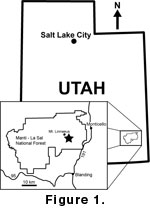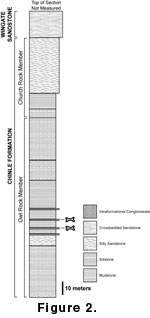GEOLOGIC SETTING
 The specimen was found southeast of Mt. Linnaeus
in the Abajo Mountains of southeastern Utah, in an area called the Red Bluffs,
part of the Manti-La Sal National Forest (Figure 1). The Abajo Mountains were
formed when an igneous intrusive body uplifted and exposed the Mesozoic
continental strata (Witkind 1964). In the immediate vicinity of where the procolophonid specimen was recovered, the exposed strata in ascending order are
the Owl Rock Member of the Upper Triassic Chinle Formation, Church Rock Member
of the Chinle Formation, and Upper Triassic/Lower Jurassic Wingate Sandstone
(Figure 2) (Stewart et al. 1972). Although the skull was recovered in a block
as float, its location and matrix make it fairly likely that it originated from
the Owl Rock Member. Extensive prospecting of the area has revealed that bone
is fairly common within the Owl Rock Member but is absent from the Church Rock
Member and Wingate Sandstone. Most bone within the Owl Rock Member at the
locality occurs within channel conglomerates that are dominated by intraformational clasts (Figure 2). However, the matrix surrounding the procolophonid indicates it is derived from a fine-grained dark red mudstone or
siltstone that is one of the most common fluvial sediments within the Owl Rock
Member.
The specimen was found southeast of Mt. Linnaeus
in the Abajo Mountains of southeastern Utah, in an area called the Red Bluffs,
part of the Manti-La Sal National Forest (Figure 1). The Abajo Mountains were
formed when an igneous intrusive body uplifted and exposed the Mesozoic
continental strata (Witkind 1964). In the immediate vicinity of where the procolophonid specimen was recovered, the exposed strata in ascending order are
the Owl Rock Member of the Upper Triassic Chinle Formation, Church Rock Member
of the Chinle Formation, and Upper Triassic/Lower Jurassic Wingate Sandstone
(Figure 2) (Stewart et al. 1972). Although the skull was recovered in a block
as float, its location and matrix make it fairly likely that it originated from
the Owl Rock Member. Extensive prospecting of the area has revealed that bone
is fairly common within the Owl Rock Member but is absent from the Church Rock
Member and Wingate Sandstone. Most bone within the Owl Rock Member at the
locality occurs within channel conglomerates that are dominated by intraformational clasts (Figure 2). However, the matrix surrounding the procolophonid indicates it is derived from a fine-grained dark red mudstone or
siltstone that is one of the most common fluvial sediments within the Owl Rock
Member.
 The Upper Triassic Chinle Formation is exposed
throughout southern Utah, southeastern Colorado, northeastern New Mexico, and
northern Arizona (Stewart et al. 1972), and represents dominantly fluvial
floodplain sediments. In southeastern Utah, the Shinarump Conglomerate, Monitor
Butte Member, Moss Back Member, an undifferentiated Petrified Forest Member,
Owl Rock Member, and Church Rock Member represent the Chinle Formation in
ascending sequence. In the Abajo Mountains,
Stewart et al. (1972: p. 288)
interpreted the lowest exposed unit as the Moss Back Member, and did not
identify the Petrified Forest Member. At the locality itself, the unit in
contact with the igneous intrusion is the Owl Rock Member. In this area, the
Owl Rock Member is dominated by slope to ledge-forming orange, red, and purple
mudstone-siltstones. Thin layers of fine sandstones are also present. Interspersed
between these layers are ledge-forming units of intraformational conglomerates
and pedogenic limestone that is generally purple in color (Figure 2).
The Upper Triassic Chinle Formation is exposed
throughout southern Utah, southeastern Colorado, northeastern New Mexico, and
northern Arizona (Stewart et al. 1972), and represents dominantly fluvial
floodplain sediments. In southeastern Utah, the Shinarump Conglomerate, Monitor
Butte Member, Moss Back Member, an undifferentiated Petrified Forest Member,
Owl Rock Member, and Church Rock Member represent the Chinle Formation in
ascending sequence. In the Abajo Mountains,
Stewart et al. (1972: p. 288)
interpreted the lowest exposed unit as the Moss Back Member, and did not
identify the Petrified Forest Member. At the locality itself, the unit in
contact with the igneous intrusion is the Owl Rock Member. In this area, the
Owl Rock Member is dominated by slope to ledge-forming orange, red, and purple
mudstone-siltstones. Thin layers of fine sandstones are also present. Interspersed
between these layers are ledge-forming units of intraformational conglomerates
and pedogenic limestone that is generally purple in color (Figure 2).
Recently, debate has centered on the
interpretation of the depositional setting of the Owl Rock Member. A number of
workers suggested that the unit was dominated by lacustrine and marginal
lacustrine environments with the limestones representing lake deposits (e.g.
Blakey and Gubitosa 1983;
Dubiel 1989,
1993). This interpretation was
challenged by Lucas and Anderson (1993) who interpreted all the limestones as
exclusively pedogenic in nature and, thus, having no bearing upon their
depositional setting. With this in mind,
Tanner (2000) undertook a detailed sedimentologic study of the Owl Rock Member. He found that while the limestones
did display a pedogenic component, they were not exclusively so, and probably
represented small ephemeral lakes and ponds within a predominantly fluvial
system. This interpretation also confirms that the Owl Rock Member conforms to
the general Late Triassic-Early Jurassic trend of increasing aridity (Tanner
2000). Thus, the Owl Rock Member most likely represents a fluvial floodplain
with sinuous streams and small ephemeral lakes and ponds that was drier than
the underlying Petrified Forest Member.

 The specimen was found southeast of Mt. Linnaeus
in the Abajo Mountains of southeastern Utah, in an area called the Red Bluffs,
part of the Manti-La Sal National Forest (Figure 1). The Abajo Mountains were
formed when an igneous intrusive body uplifted and exposed the Mesozoic
continental strata (Witkind 1964). In the immediate vicinity of where the procolophonid specimen was recovered, the exposed strata in ascending order are
the Owl Rock Member of the Upper Triassic Chinle Formation, Church Rock Member
of the Chinle Formation, and Upper Triassic/Lower Jurassic Wingate Sandstone
(Figure 2) (Stewart et al. 1972). Although the skull was recovered in a block
as float, its location and matrix make it fairly likely that it originated from
the Owl Rock Member. Extensive prospecting of the area has revealed that bone
is fairly common within the Owl Rock Member but is absent from the Church Rock
Member and Wingate Sandstone. Most bone within the Owl Rock Member at the
locality occurs within channel conglomerates that are dominated by intraformational clasts (Figure 2). However, the matrix surrounding the procolophonid indicates it is derived from a fine-grained dark red mudstone or
siltstone that is one of the most common fluvial sediments within the Owl Rock
Member.
The specimen was found southeast of Mt. Linnaeus
in the Abajo Mountains of southeastern Utah, in an area called the Red Bluffs,
part of the Manti-La Sal National Forest (Figure 1). The Abajo Mountains were
formed when an igneous intrusive body uplifted and exposed the Mesozoic
continental strata (Witkind 1964). In the immediate vicinity of where the procolophonid specimen was recovered, the exposed strata in ascending order are
the Owl Rock Member of the Upper Triassic Chinle Formation, Church Rock Member
of the Chinle Formation, and Upper Triassic/Lower Jurassic Wingate Sandstone
(Figure 2) (Stewart et al. 1972). Although the skull was recovered in a block
as float, its location and matrix make it fairly likely that it originated from
the Owl Rock Member. Extensive prospecting of the area has revealed that bone
is fairly common within the Owl Rock Member but is absent from the Church Rock
Member and Wingate Sandstone. Most bone within the Owl Rock Member at the
locality occurs within channel conglomerates that are dominated by intraformational clasts (Figure 2). However, the matrix surrounding the procolophonid indicates it is derived from a fine-grained dark red mudstone or
siltstone that is one of the most common fluvial sediments within the Owl Rock
Member.